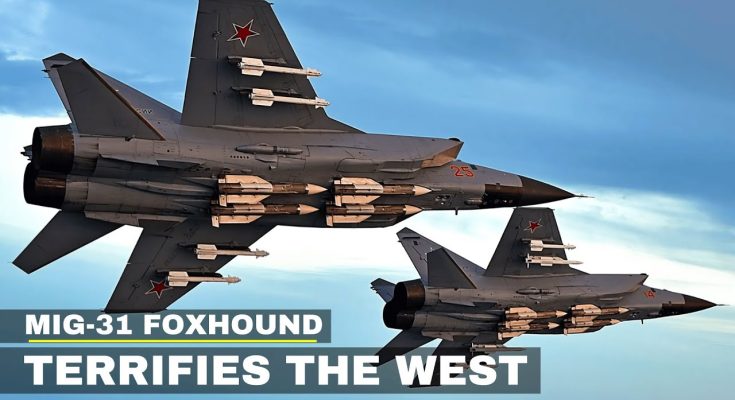The MiG-31 Foxhound is indeed a formidable aircraft that has earned a reputation for being a significant threat, particularly to NATO forces. Developed by the Soviet Union and still in service with Russia, it’s a supersonic interceptor and one of the fastest combat aircraft in the world. Here’s why it’s so terrifying to NATO and other military forces:
1. Incredible Speed and Range:
The MiG-31 is capable of reaching speeds of up to 2.83 Mach (around 3,000 km/h or 1,864 mph), which makes it one of the fastest military aircraft in operation. This speed gives it the ability to intercept and neutralize enemy aircraft, including high-speed bombers and reconnaissance planes, before they can enter Russian airspace. With a combat range of over 2,000 kilometers (1,243 miles), the MiG-31 can patrol vast stretches of airspace and engage targets at long distances.
2. Long-Range Radar and Targeting Capabilities:
The MiG-31 is equipped with the Zaslon radar, one of the most advanced radar systems of its time. This radar can detect and track multiple targets at ranges of up to 200 kilometers (124 miles), and even engage multiple aircraft simultaneously. The radar’s ability to detect stealthy or high-speed targets, such as cruise missiles, adds to the MiG-31’s lethality. It can also work in coordination with ground stations and other aircraft for extended surveillance.
3. Air-to-Air Missiles (R-33/R-37):
The MiG-31 is designed to carry large, powerful air-to-air missiles, particularly the R-33 and R-37. The R-33 has a range of up to 150 kilometers (93 miles), while the R-37 has a staggering range of around 300 kilometers (186 miles), making it effective against both high-speed and high-altitude targets. The ability to engage enemy aircraft from such long distances is a significant advantage, making it difficult for adversaries to retaliate or even evade the MiG-31.
4. Role in Anti-Bomber and Anti-Cruise Missile Warfare:
The MiG-31 is specifically designed to counter fast and high-altitude bombers, as well as cruise missiles. NATO’s strategic bombers, like the B-2 Spirit or B-52 Stratofortress, are often considered vulnerable to the MiG-31’s long-range interception capabilities. The aircraft’s speed, radar systems, and missile payload make it an ideal platform for defending Russian airspace against such threats.
5. High-Altitude Interception:
The MiG-31 can operate at very high altitudes, which allows it to target incoming threats from a superior position. Its ability to fly at altitudes of up to 20 kilometers (65,000 feet) gives it an edge in engaging enemy aircraft at their own operating altitudes, making interception more efficient and difficult to counter.
6. Threat to NATO’s Air Supremacy:
NATO has long relied on its advanced fighter jets, such as the F-22 Raptor and F-35 Lightning II, to maintain air superiority. However, the MiG-31’s ability to target NATO aircraft from extremely long distances, especially with its advanced missile systems, poses a challenge to this air dominance. The MiG-31’s speed and missile range make it a dangerous adversary for NATO’s most advanced stealth aircraft, especially in the context of air defense over Russia and Eastern Europe.
7. Adaptability and Upgrade Potential:
Although the MiG-31 was developed in the 1970s and 1980s, it has undergone several upgrades, including the MiG-31BM version, which enhances its avionics, radar, weapons, and communications systems. This upgrade ensures the MiG-31 remains a relevant and potent force against modern military aircraft, keeping it a viable threat to NATO.
8. Asymmetric Threat:
The MiG-31 is not designed for dogfighting or air superiority in the traditional sense, but rather for intercepting and neutralizing high-priority targets at long ranges. This makes it an asymmetric threat, especially against NATO’s focus on precision strike and stealth. The aircraft’s specialized mission set means it can often surprise adversaries who are not fully prepared to counter its capabilities.
9. Psychological Impact:
The mere presence of MiG-31s in Russian airspace can create significant psychological pressure on NATO forces. The aircraft’s potential to disrupt air operations, especially in regions like the Baltic or Black Sea, means NATO forces need to carefully consider their tactics when operating near Russian borders. NATO has to account for the MiG-31’s ability to target high-value assets such as reconnaissance planes, bombers, and fighters.
10. Potential for Future Upgrades:
Russia’s continuous development of the MiG-31 suggests it may remain a potent threat for many years. There are reports indicating that Russia is working on future versions of the MiG-31 or even plans to integrate the aircraft into more advanced systems, such as working alongside drones or new missile technologies. This could make the MiG-31 even more dangerous in the coming decades.
In summary, the MiG-31 Foxhound is a truly menacing aircraft due to its speed, long-range interception capabilities, advanced radar, and specialized mission focus. It remains one of the key pieces in Russia’s air defense strategy, and it represents a significant threat to NATO, particularly when it comes to defending against bombers, missiles, and other high-priority aerial threats. The MiG-31’s combination of speed, radar systems, and missile range make it a formidable adversary for any military force.
